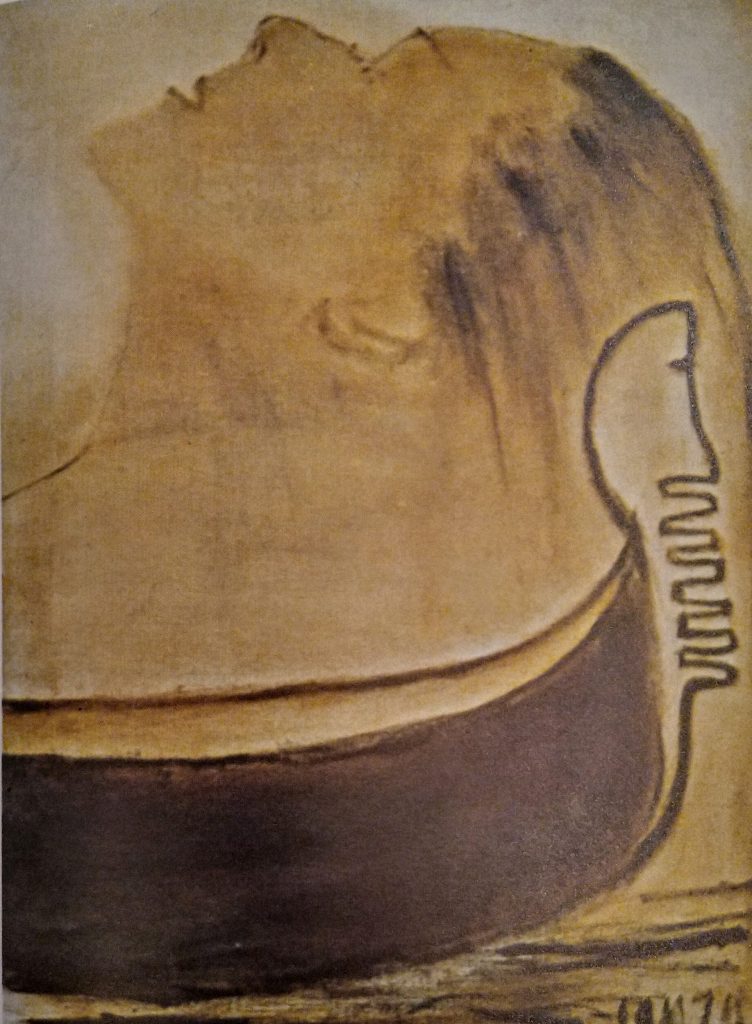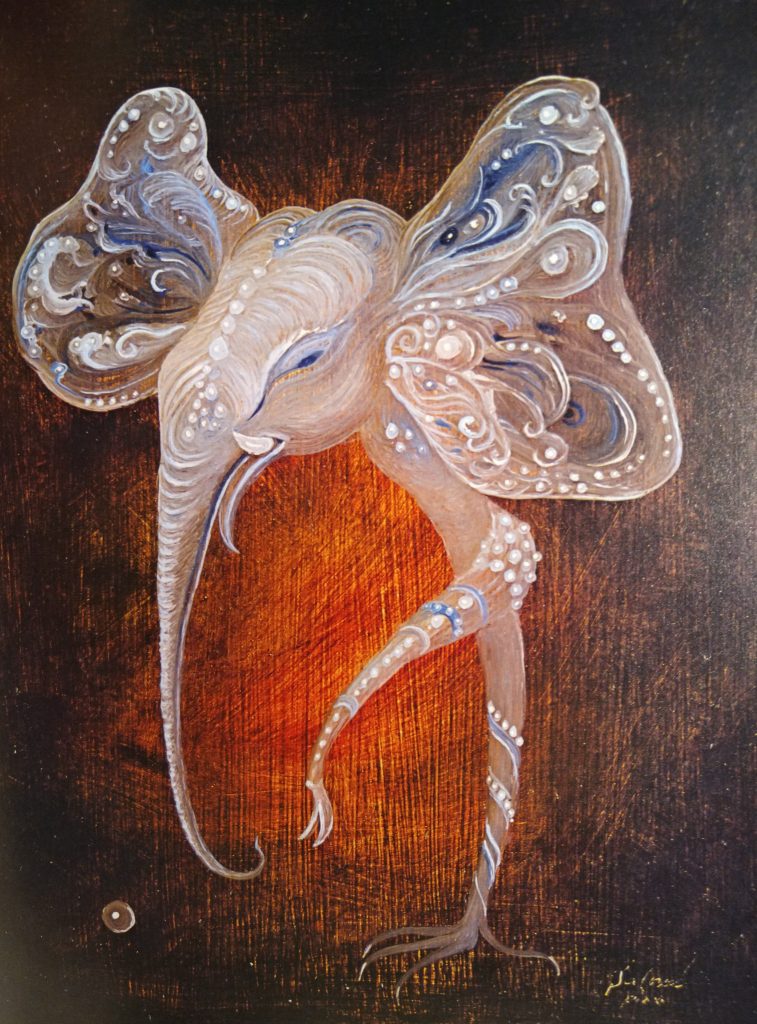Arte Medianica: “From a formal point of view these works present an exceptional richness and an incredible exuberance of decoration, which at times borders on the baroque and at other times it is simply playful or of a magical flavour; a true feast of colours, a profusion of symbols and a very marked ornamental taste. Above all they are beyond all style, trend and artistic current, and are not part of any era or school. It is a timeless art, or, better, out of time.” Paola Giovetti 1982
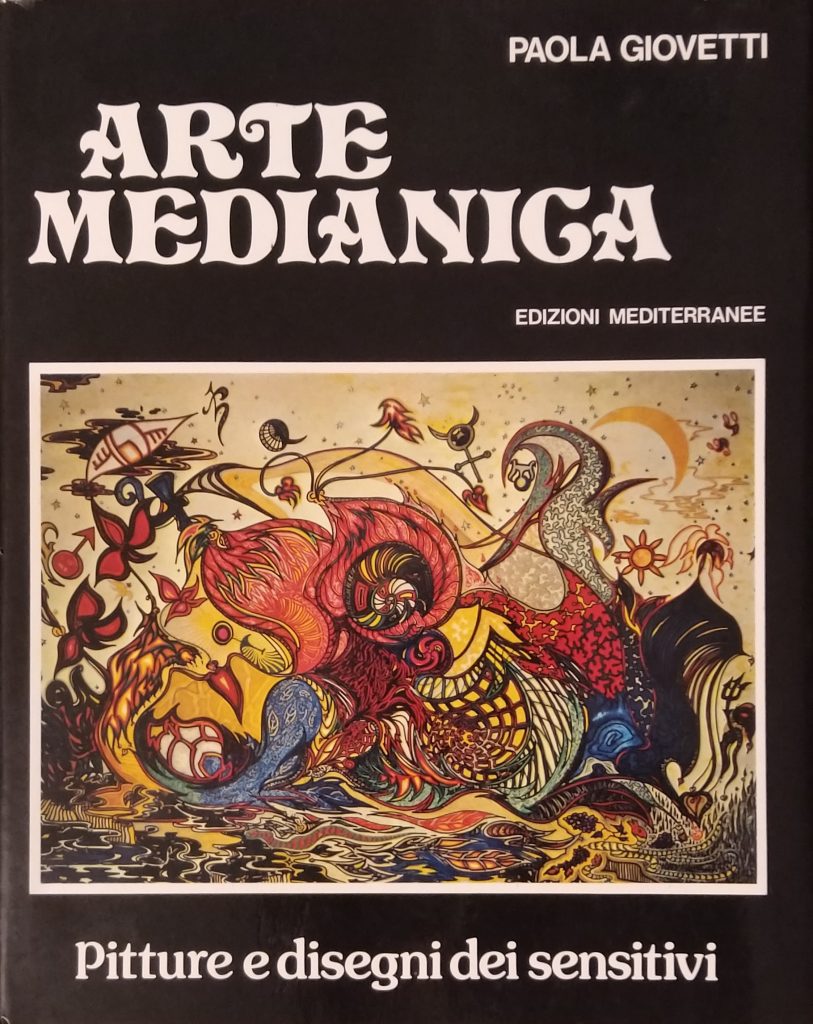
Paola Giovetti is a renowned parapsychologist and author with a special interest in mediumistic art. In the late 1970s and early 1980s she wrote a groundbreaking book called Arte Medianica which brought together a collection of in depth case studies on artists working in this field along with historically important practitioners such as Leon Petitjean, Augustin Lesage, Fleury Joseph Crépin and Heinrich Nüsslein. The book was published by Edizioni Mediterranee in 1982 and today, nearly forty years later, still remains one of the seminal texts on this genre of art.
In December 2020, I had the pleasure of exchanging emails and interviewing Paola about Arte Medianica and her research into its collection of incredible artists. It was a wonderful experience for me and I have learned a great deal from Paola’s insights into a genre of art that has fascinated and perplexed parapsychologists, art historians and psychologists for over a century.

Tell us a bit about your background in parapsychology. You’ve worked in this field for many years, what attracted you to it?
I have always had a taste for Mystery and have always tried to understand more about it – of us, the meaning and purpose of life, our ultimate destiny. However, an accident I had many years ago put me directly on the path of research in this field. I was run over while I was skiing and a ski hit me in the right brow bone, giving me a concussion. It wasn’t serious, but the doctor who treated me told me if the ski had hit me with the same violence an inch to the right or left, that is on the temple or in the eye, I would probably have died.
The awareness of this led me to ask myself many questions. What would have happened to me, what would I have seen if my earthly life had ended that day? This was the push I needed to deepen my research. I was brought up a Catholic and have always been led to believe in an “after”, but I felt the need to know more. I began to investigate near-death experiences (NDE) and read everything I could find on the subject. I also carried out an Italian investigation on the subject, on which I wrote my first book. In the meantime I had left teaching and started a career as a journalist and writer specializing in frontier issues.
In this capacity I began to frequent the world of parapsychology: researchers, experimenters, scholars, psychics etc. were all of interest to me and I was fortunate to have the opportunity to approach and interview them for the newspapers I worked with. This allowed me to encounter the most diverse environments, both in Italy and abroad.
As a journalist and writer you have researched extensively and written about prominent visionaries such as Blavatsky, Steiner, Goethe and Swedenberg, but one of your first books was Arte Medianica. How did you become interested in mediumistic art?
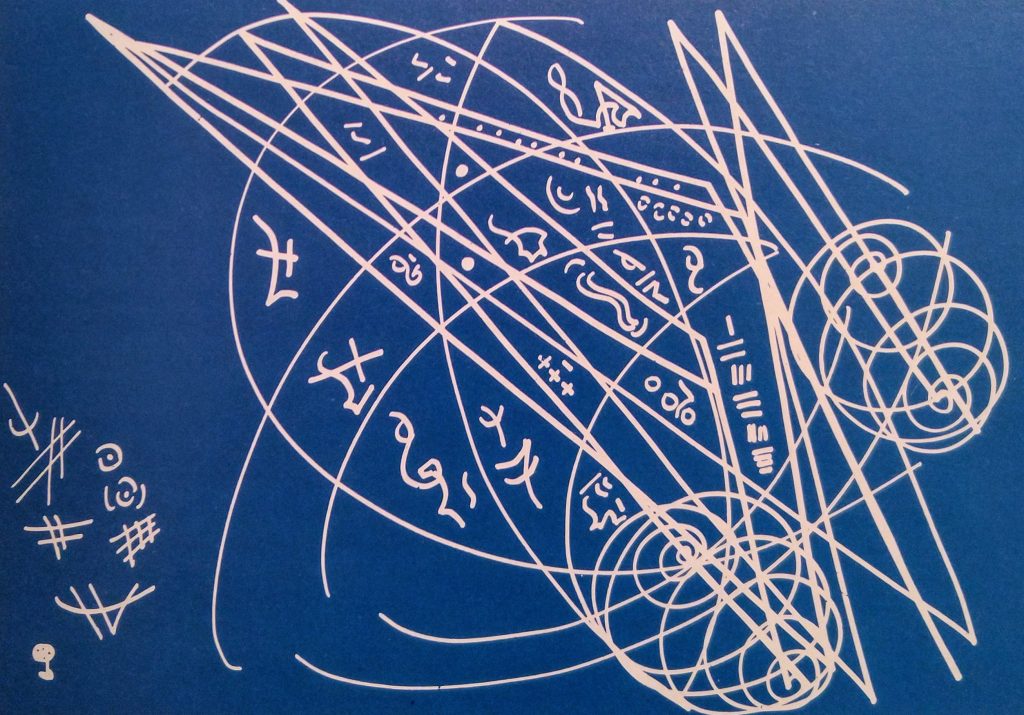
I was directed towards mediumistic art through the friendship of one psychic in particular, Milly Canavero from Genoa who was one of the cases described later in my book. She was a lady who had by chance discovered her ability to practice automatic writing and later, unexpectedly, had begun to draw. Every day at the same time she felt compelled to take paper and pen and execute at great speed three perfect geometric drawings, accompanied with a message that explained their meaning. I immediately became interested in her case and followed her development for a long time which enabled me to see her draw and write. I knew, thanks to my research, of the existence of automatisms, but having direct experience led me to deepen my interest in the subject.
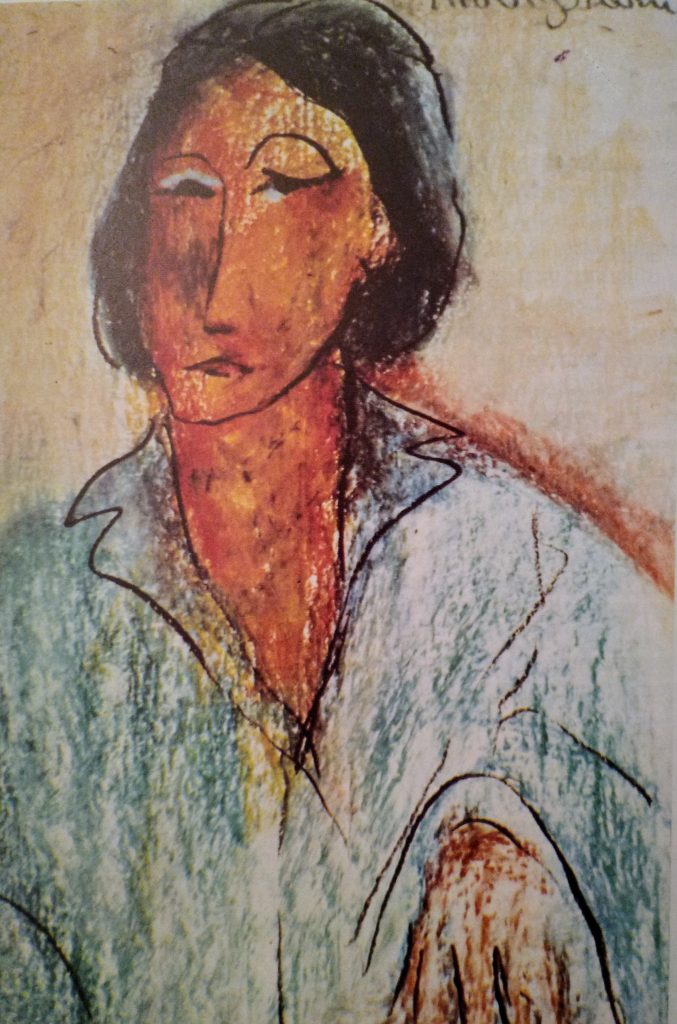
In the same period (late 1970s) I was invited to Milan to meet and see at work the Brazilian mediumistic painter of Italian origin, Luiz Antônio Gasparetto (1949-2018). He made a great impression on me and a chapter of my book is dedicated to him too. In a trance, with his eyes almost closed, to the rhythm of Vivaldi’s The Four Seasons, he executed in a very short time, distributing the colours directly with his hands, paintings in the very recognizable style of great painters of the past. He could complete ten to twelve paintings in a session of an hour. Seeing him work was truly an incredible sight. Later, I met other Brazilian mediumistic painters who worked in the same way as him, always donating the proceeds of the paintings to charity when they were sold at auction at the end of the session. They were all very good, but Gasparetto in particular, who passed away a few years ago and which I also brought to television on RAI 1, remained in my heart.
It was also around that time that I had the opportunity to participate in the meetings of the great psychic (but it would be better to say “enlightened”) Gustavo Adolfo Rol of Turin (1903-1994) who, among other phenomena, also produced ‘direct’ paintings and drawings, that is, without touching the paints, pencils and brushes: an incredible phenomenon which I personally experienced with many other witnesses and saw no reason to doubt. A chapter is also dedicated to Rol in the book.

From these experiences I became more and more involved with the field of mediumistic art, and as an art lover it was a particularly fascinating area for me. I wrote articles on these encounters which led to other great and interesting meetings.
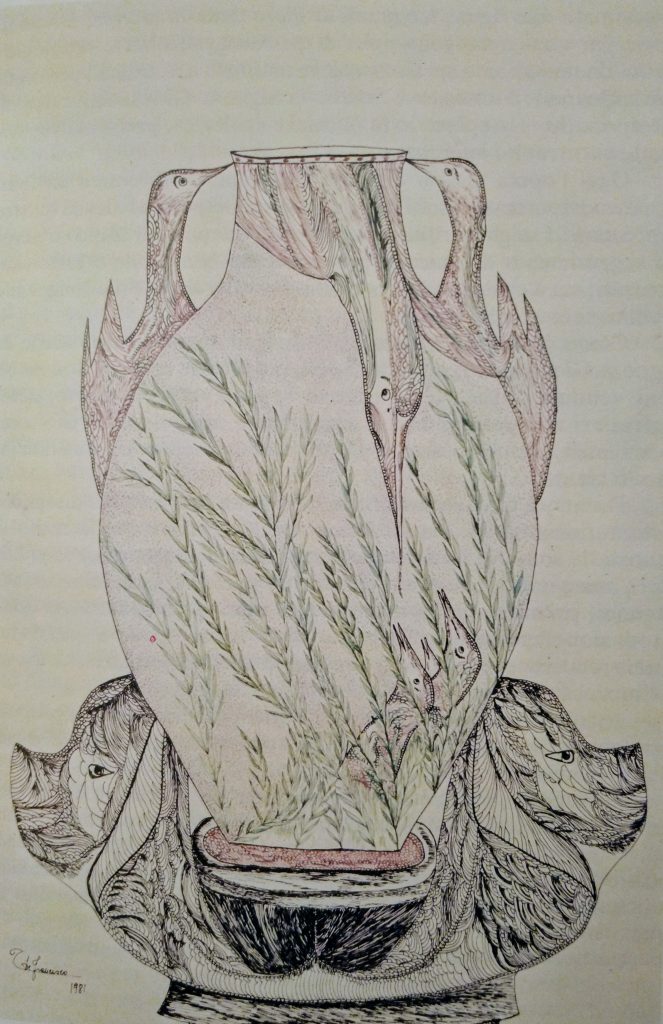
For example, in Italy, the Venetian boatman Narciso Bressanello, who I had the opportunity to meet, the extraordinary artist Luisa Giovannini, the dental technician Giuseppe Lanzillo who painted at night in a somnambulistic state and Evelyne Disseau, a French resident in Milan. From abroad I discovered Salomè, Gertrud Emde and through her Fritzi Libora Reif, who wanted to do my ‘Portrait of the soul’, the English psychic Matthew Manning, the English mediumistic portraitist Coral Polge that I saw working several times, and the extraordinary Emma Kunz, who passed away in 1963, who was introduced to me by her great friend Anton Meier. He had been cured by her of infantile paralysis and was the guardian of her legacy and creator of the Museum where her works are kept.
I also did a lot of research at the Biblioteca Bozzano De Boni in Bologna where I am now President. It was established in 1909 by parapsychologist Ernesto Bozzano and is the custodian of a large collection of specialized material dedicated to psychic research. Further research was helped by Professor Hans Bender of the Institut für Grenzgebiete der Psychologie und Psychohygiene (IGPP) in Freiburg, Germany. He allowed me to consult various books and even lent me a unique and therefore very precious book on Margarete Held.
As what frequently happens when I carry out research, the material almost “came to meet me”, so that in a relatively short time I was able to put together a large number of cases, mostly collected directly from the respective artists. A beautiful experience.
What is your definition of mediumistic art and why do you think it is special?
Mediumistic art is absolutely special for various reasons. It is not classifiable in any artistic group as the productions vary greatly and they are not attributable to any specific style. At the same time though, the artists can present in their modus operandi very similar characteristics while working in different places and at varying times without knowledge of each other or sharing social and cultural backgrounds. It is in this aspect that that makes them especially important and significant.
What are these characteristics? First of all, the drive to produce art is usually sudden and irresistible, and is experienced almost passively, as something foreign or even as a possession. Some even claim that it is as if they see another creating the drawing or painting. Others always produce at the same time and feel the need wherever they are. There are also those who get up regularly every night to paint, as if in a sleepwalking state.
Generally, when they start a work, these people do not have the slightest idea of what will come of it and fully realize it only once the work is done. That is, the programming phase is totally missing with no plans or preliminary sketches being made. Sometimes they cannot explain what their art represents and receive the explanation afterwards through automatic writing. Some work at very high speed and complete the work in a very short time time, a few minutes or even seconds, others can take months, as they start the work when they feel the urge, but must stop at a certain point because the drive fails and they can only go back to work when the mysterious impulse is felt again.
Some of these artists work in a more or less deep trance, or even in course of real mediumistic sessions. Most work with a detachment from the surrounding environment in a state of serenity and joy whilst in a heightened or even hypnotic state of consciousness. At the end of the work they feel lightened, rarely tired and with a sense of great satisfaction.The works produced, independent of academic styles and artistic trends, show a marked ornamental taste with a great wealth of colours, symbols and decorations. They often contain paranormal, clairvoyant and precognitive elements. Sometimes the works are in the style of historic painters and signed with the name of the presumed illustrious artists.
These artists have a very strong emotional relationship with their works. They attribute a special value to them and often refuse to sell. Also, because they have a clear tendency to what is sacred, numinous, distant, otherworldly and even extraterrestrial. All these characteristics and the strange mechanics of production mean that the artist does not attribute his productions to himself, but to external intelligences that use him to bring their works to this world.
Automatism is a common technique used by mediumistic artists. Can you explain what that is?
The term automatism means an action not controlled by the will, which takes place without conscious control, or with very little conscious control. It is the object of study for psychic research as through automatist productions, that take place in unusual external conditions and that do not seem to be the work of who is writing, drawing or painting, paranormal information and/or information not attributable to the culture of the person in question can be highlighted.
The German doctor and parapsychologist, Rudolf Tischner, defined the automatists as “risers of the unconscious”. Virtually everyone, with good will and with training, can manage to communicate with their unconscious through the simplest automatism. In the most gifted people (psychics) the automatism occurs spontaneously and unexpectedly, without a particular exercise, One of the most common automatic productions concerns writing, usually formed from a grand message often concerning spiritual themes and rules of life, as well as (apparent) contacts with disembodied personalities.
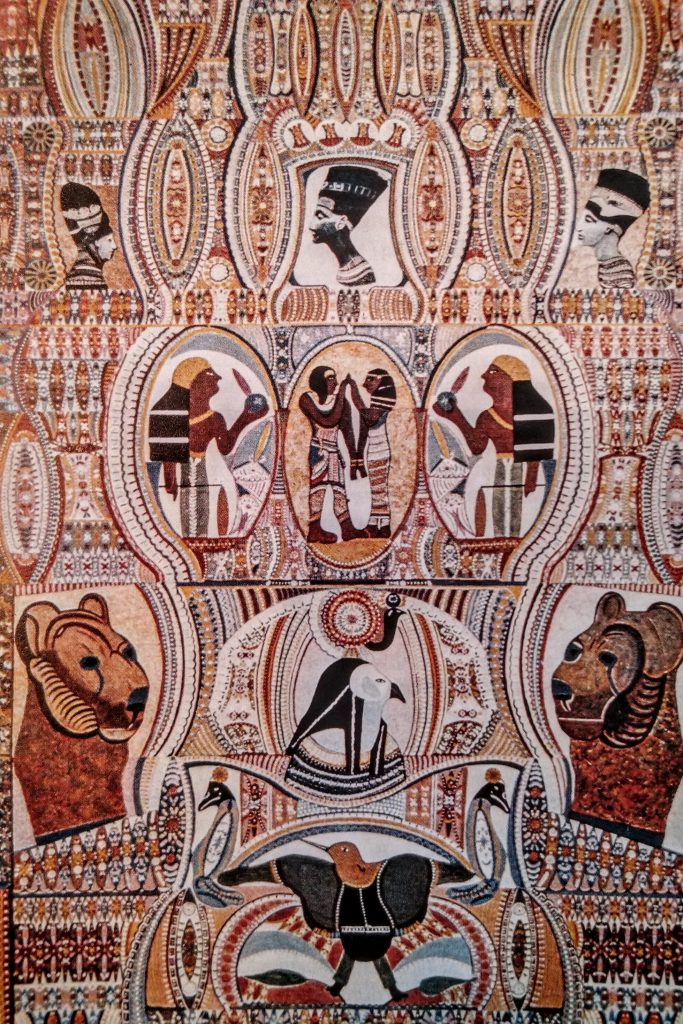
Another is artistic productions and through the hands of the subject, most of the time not in a trance but in a state of ‘concentration’, paintings and drawings of fine workmanship are born, totally beyond the powers of the artist, who in general has never painted or drawn, nor would be able do it on a normal level and usually has never even thought or wanted to engage in such an activity. These are the “peintres sans avoir appris” as Dr. Eugène Osty describes them – artists without having learned to be. They are people, often at a more mature age, who are seized by an irresistible impulse to paint, feel induced to buy colours and brushes and they begin – precisely by automatism and without conscious participation and/or planning – to produce works that they would never have thought of doing.
Art Medianica is one of only a few books devoted to this frequently overlooked category in art and psychic study. How was it received in those fields when it was published in 1982?
My book Mediumistic Art is one of the very few published on this subject, practically the only one in Italy. The reception was good among the ‘experts’, that is to those who were interested in psychic research and its phenomena. At an academic level … absolute silence, although the book has a preface by Franco Miele, a well-known and appreciated painter – and not mediumistic! Mediumistic art involves a niche audience, although, in my opinion, it should be of interest not only to art critics and historians but also to psychologists for its unusual ways of manifestation.
Who would you say is Italy’s best known mediumistic artist and is mediumistic art represented in any of Italy’s public collections?
In Italy we do not have an extraordinary case like that of Augustin Lesage which attracted the attention not only of the public, but also of scholars; or like the Swiss artist, Emma Kunz, whose works are displayed in a museum. Monographic books are dedicated to them and both cases are presented in my book. Italian mediumistic artists are not at this level, even though they present motifs of great interest, and none of their works are present in public collections, for now.
One of the great qualities of Arte Medianica is that it focuses mainly on living artists and the descriptions of their artistic processes are in their own words. Were you able to observe them working and do you have any memorable moments from your meetings?
I did have the opportunity to observe some of these artists at work, and I must say that it was a singular experience. I remember, for example, Milly Canavero, who I often visited and was a very good friend. Once I was staying as a guest in her house for a few days and at a certain time in the afternoon she ‘had’ to take a pen and paper and start drawing. She took no more than 30 seconds for each drawing and then, more slowly, she wrote the message that explained its meaning. After the act of drawing and writing, she felt joyous, lighter and content, like someone who has completed the task of the day.
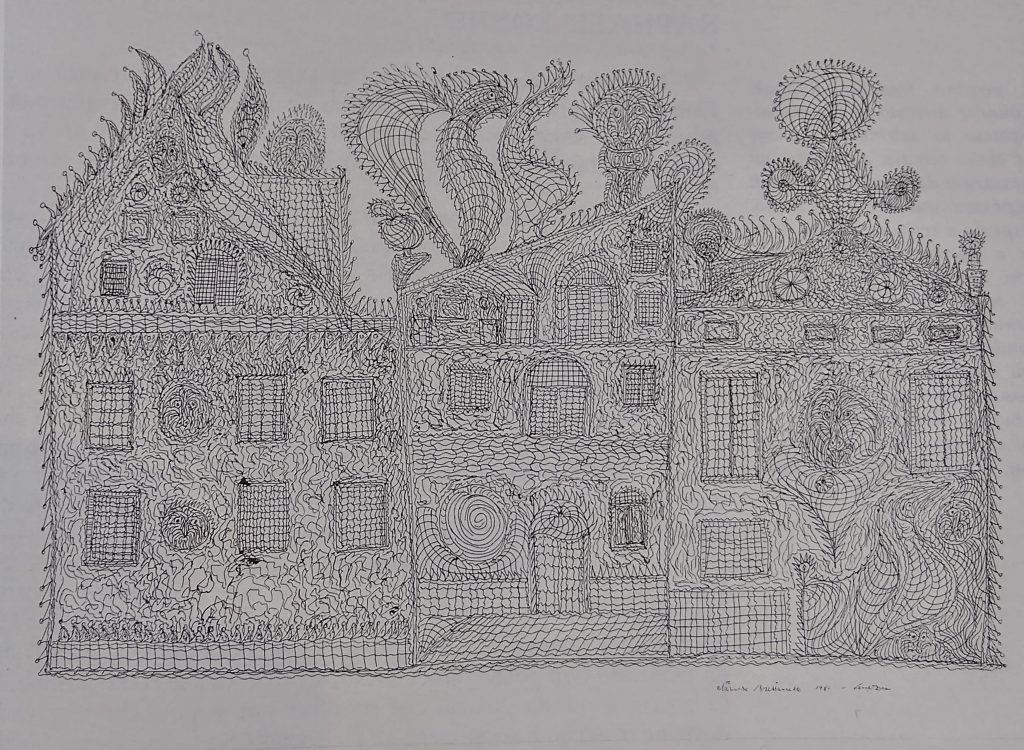
Another very interesting character was the Venetian boatman Narciso Bressanello, who in his life had always worked hard repairing boats and heavy fishing nets, a tiring job that had hardened his hands. When he began to feel the urge to draw and portray images that seemed to be made of lace, he found it necessary to buy very fine drawing pencils. Well, he found it very difficult to hold them as he said that his fingers did not bend enough to hold objects so small and light. In fact, it took a long time before he could do it without too much effort.
Outstanding is the unique case of Gustavo Rol, the extraordinary Turin character who created a painting in the style of Picasso ‘appear’ with his signature on a sheet of paper that I chose and had placed in the holder. I also selected which painter he would portray and described the scene I wanted to be represented. In his long working life, always private and non-profit, Rol produced dozens of ‘direct’ paintings and drawings, that is without contact with the material.
Were they difficult to find and were there any strange events that happened around the research for the book?
When I began, through Milly Canavero. to become interested in mediumistic art, the material came practically by itself. A few articles written for various magazines were enough to put me in contact with a vast case history. For example, the case of Narciso Bressanello was reported to me by a friend, the director of Venice’s Chamber of Commerce, who on his way to work one day passed by Narciso’s open studio and saw him intently drawing instead of repairing the fishing nets. Intrigued, he entered and talked to him about his work, later becoming good friends. I wrote about their chance encounter in the book and my invitation to go to Venice to meet this very special character. Something similar happened with Giuseppe Lanzillo from Bologna, After having met various Italian mediumistic painters and draftsmen I wanted to see what had happened abroad in this field, and so I met other artists. I met Salomè because she looked for me after reading my article in a German magazine. So in a relatively short time I collected a good case study – and I got the idea of the book.
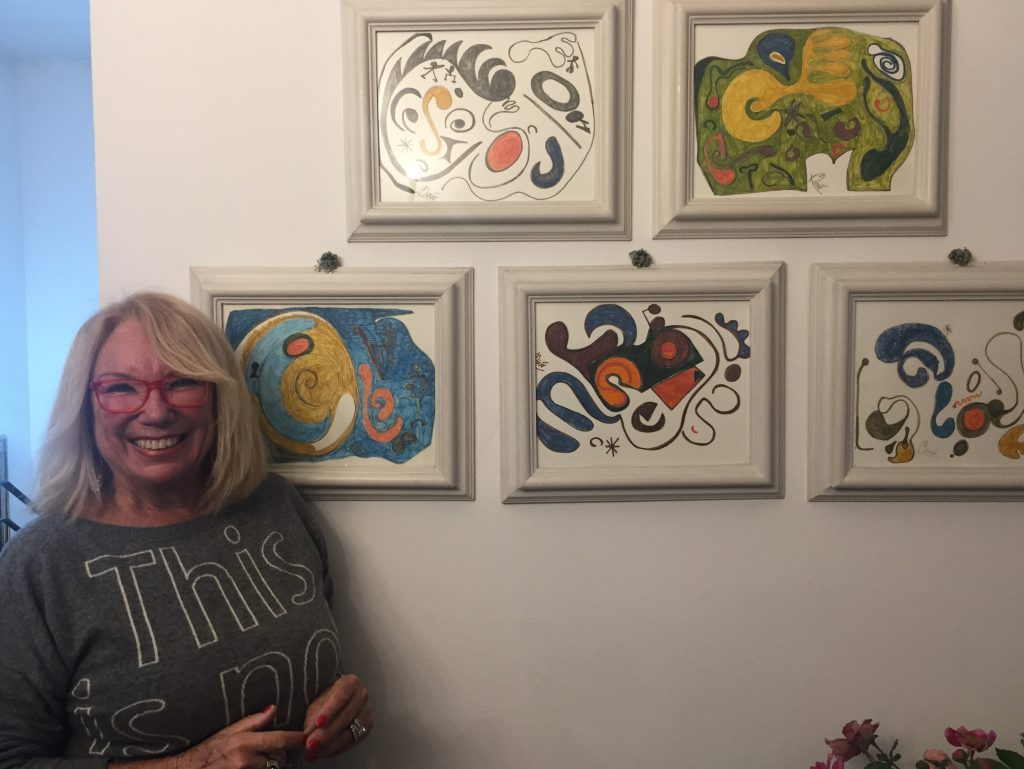
Do you know if your book has inspired others to share their artistic mediumship or become involved in mediumistic art for the first time?
Reading my book introduced me to some other mediumistic artists; the most interesting case is that of Clara Pasini, a lady from Cesena who is an optician by profession and manages the family opticians shop. She unexpectedly began first to draw and then to paint works in the style of Joan Mirò, who before then she had never even heard of and did not even like the style which was totally different from her usual taste. Clara also writes very beautiful messages in which Mirò tells her that he chose her so he was able to continue painting. After Arte Medianica was published, I also met two very interesting mediumistic sculptors which at the time I was writing my book I had not yet met any. Sculpture is much rarer than painting and drawing because it requires more complex times and methods. These were the works of Amedeo Boldrini and Neri Flavi.
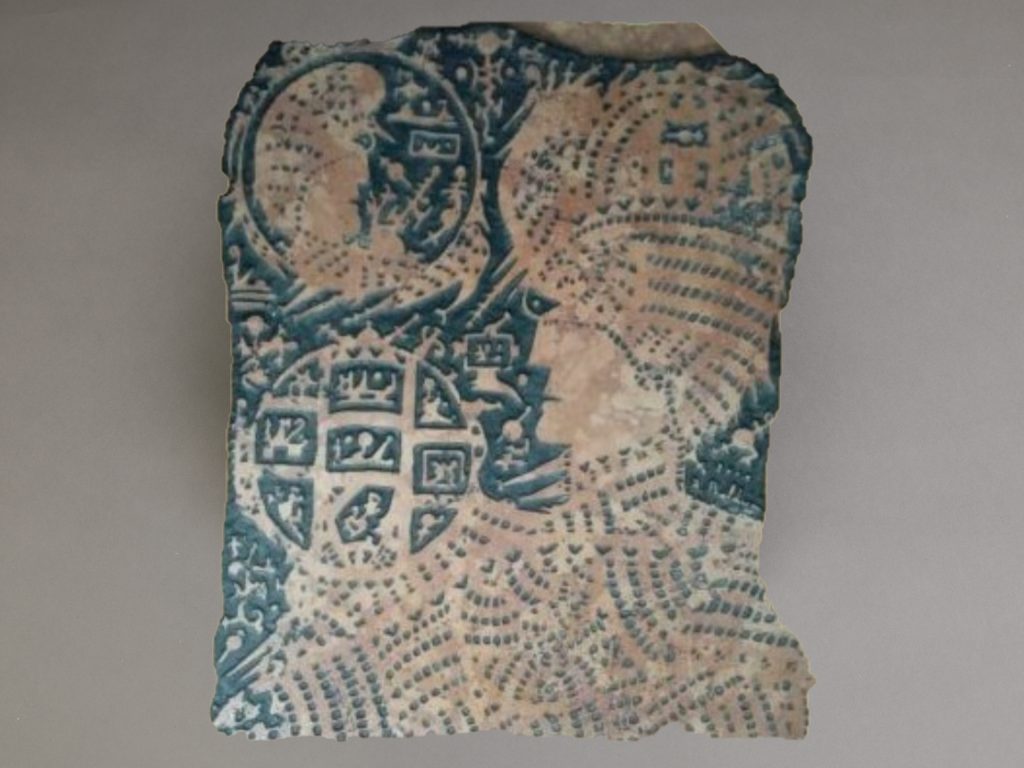
One of the artists featured was Fritzi Libora Reif who drew one of her beautiful soul portraits for you. Have you built a collection of mediumistic art?
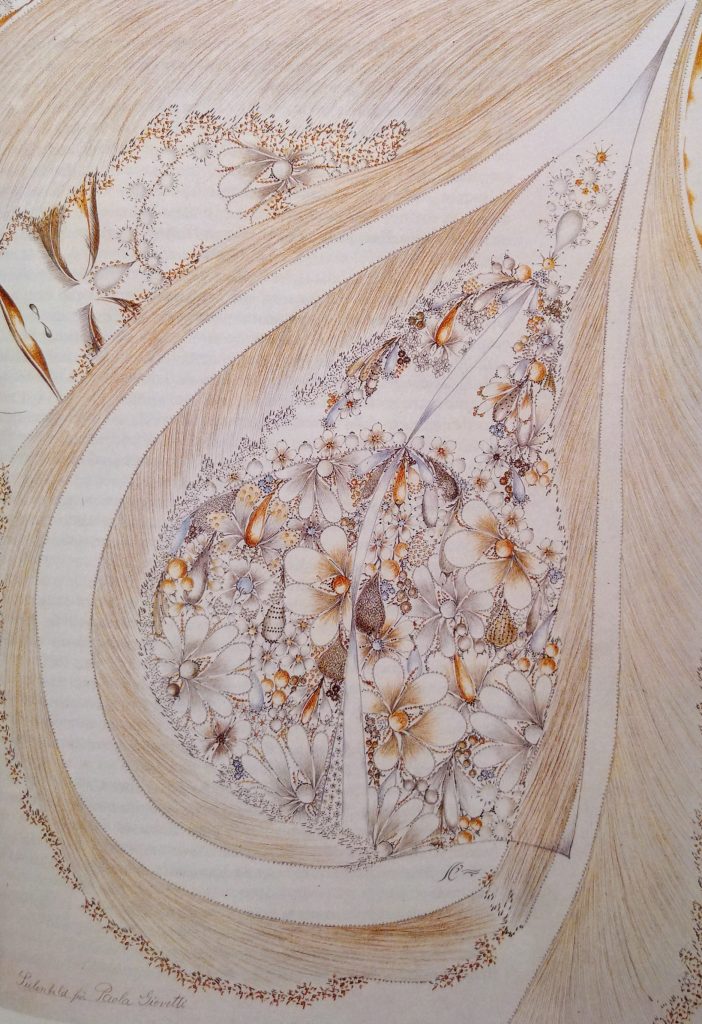
© Paola Giovetti
The meeting with Fritzi Libora Reif is one of my best experiences. I was led to her by Gertrud Emde, who I in turn had met through Gertrud’s husband, a gentleman I met at parapsychology congresses in Germany. He told me about his wife who was a mediumistic painter and on one occasion when I was their guest they took me to meet Fritzi, who wanted to have a photograph of me and made my “portrait of the soul”. I have a very small collection of mediumistic works, those that have been given to me. The works of mediumistic artists are not bought, they do not sell them, it is usual for them to give them to someone.
Many mediumistic artists are untrained and felt compelled to create art after a traumatic event, illness or an unexpected spiritual vision. They have therefore historically been classed as outsider or art brut artists. Do you think this label has helped or hindered them from being accepted as mainstream artists or for the establishment of spirit art as its own genre?
I think this label has not helped mediumistic artists to be accepted and studied. The fact is that their art is spiritual and does not respond solely to aesthetic requirements. It is also necessary to know the conditions in which these works are produced and the meaning they conceal within themselves. For example, in the aforementioned case of Clara Pasini, whoever sees her works thinks of good imitations of Miro, and that’s it. And if they do not know the production methods they do not consider them worthy of attention. Many of these works, however, are not of particular value, they are pleasant but nothing more. Interesting is how they are created, under what conditions and situations, and why.
What do you think of the attention from the art world that mediumistic artists like Hilma af Klint, Emma Kunz and Georgiana Houghton are finally receiving? Why is mediumistic art so appealing now? What would you like to see for the future of mediumistic art?
Perhaps the time is coming when mediumistic art can receive the right attention. As I have already mentioned, this particular type of art should also involve others and in particular psychologists who could shed light on that wonderful enigma that is artistic creation.
Arte Medianica is written in Italian by Paola Giovetti and published by Edizioni Mediterranee and can be found online in bookstores such as abebooks. It features the following artists: Leon Petitjean, Augustin Lesage, Fleury Joseph Crépin, Heinrich Nüsslein, Liena, Clara Schuff, Gertrud Emde, Salomè, Giuseppe Lanzillo, Faroxis, Gustavo Adolfo Rol, Matthew Manning, Coral Polge, Luiz A Gasparetto, Giovanna Bergamini, Laure Pigeon, Luisa Giovannini, Narciso Bressanello, Raphael Lonné, Milly Canavero, Evelyne Disseau, Emma Kunz, Margarethe Held, Iris Canti, Fritzi Libora Reif, Takeshi Mochizuki, Sri Chinmoy and Heita Coponi. Visit our artists page to see more information on several of these artists.
